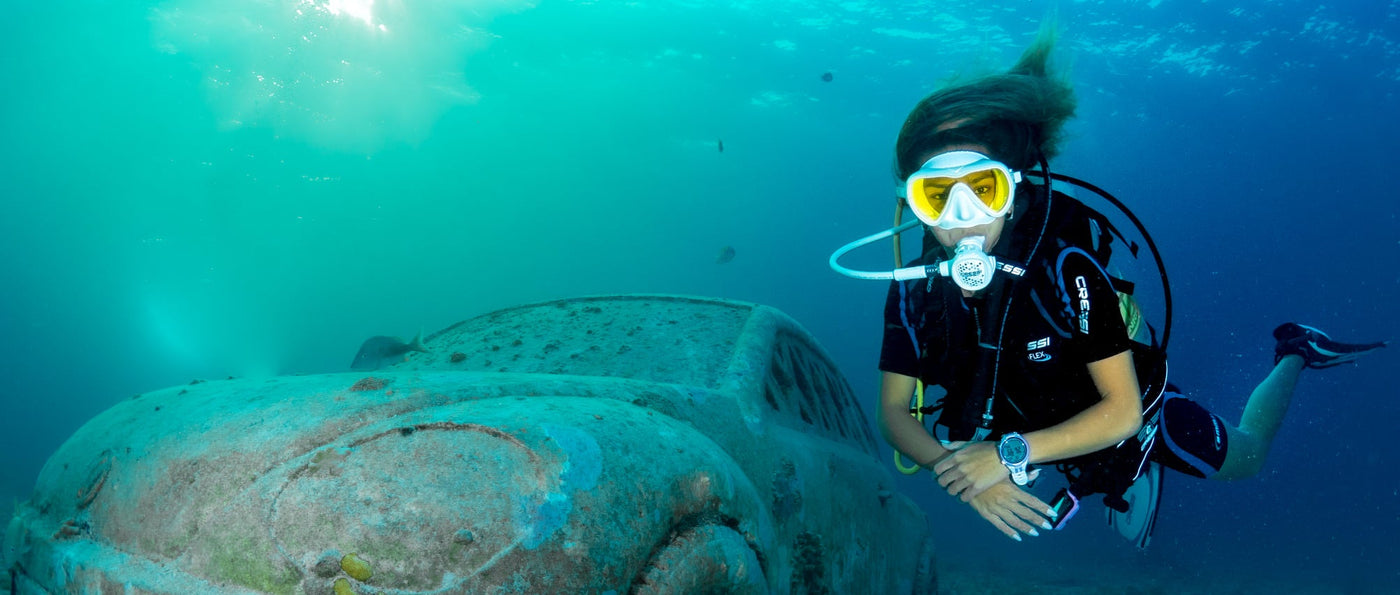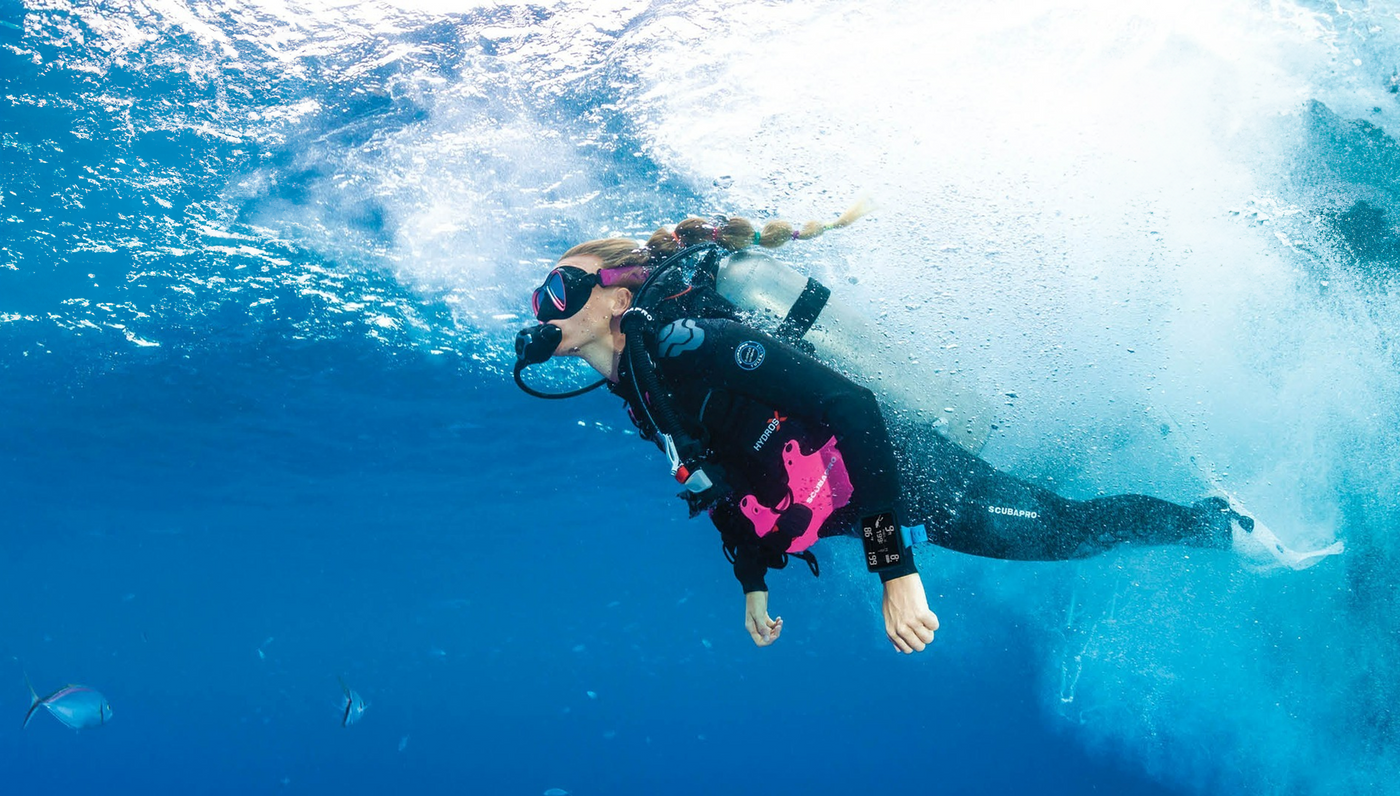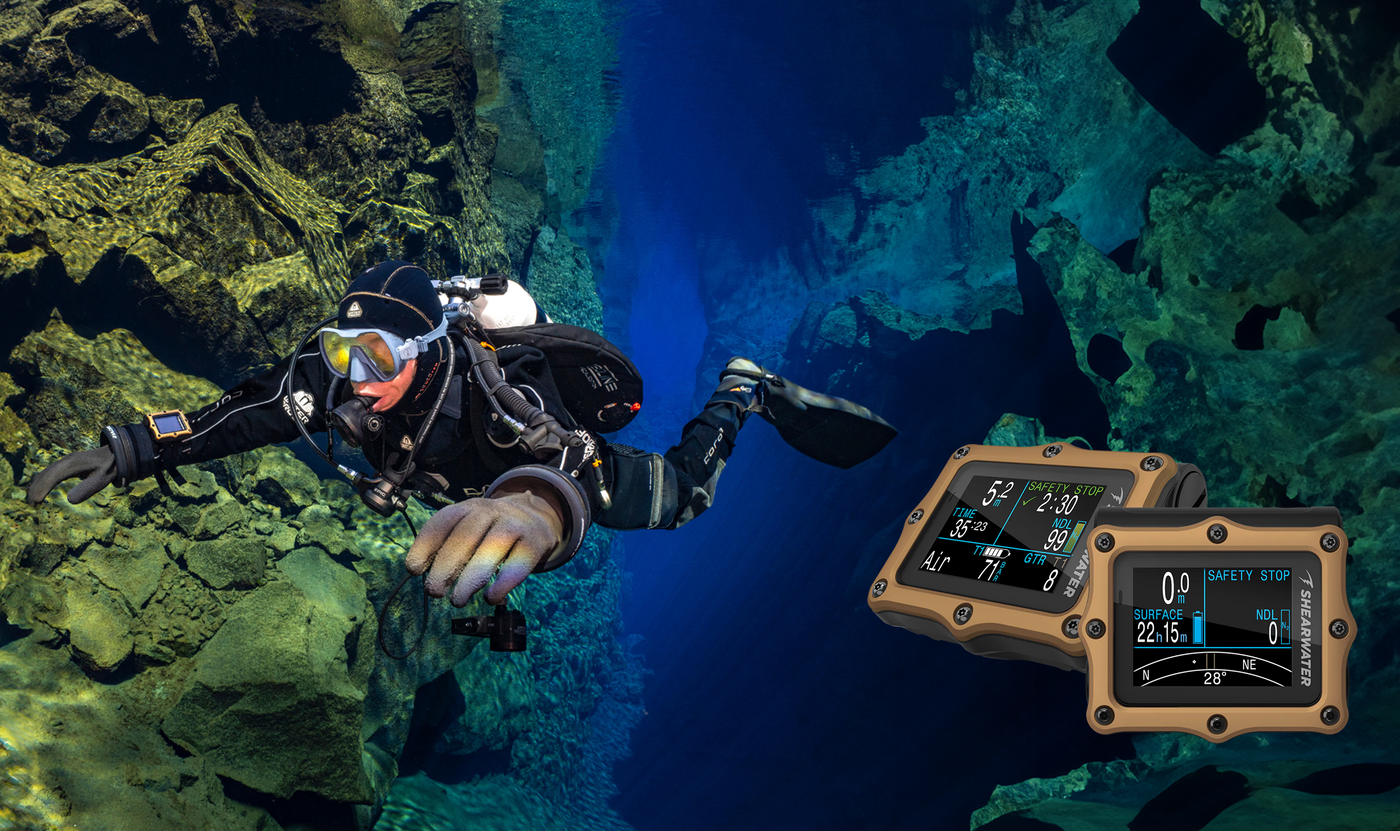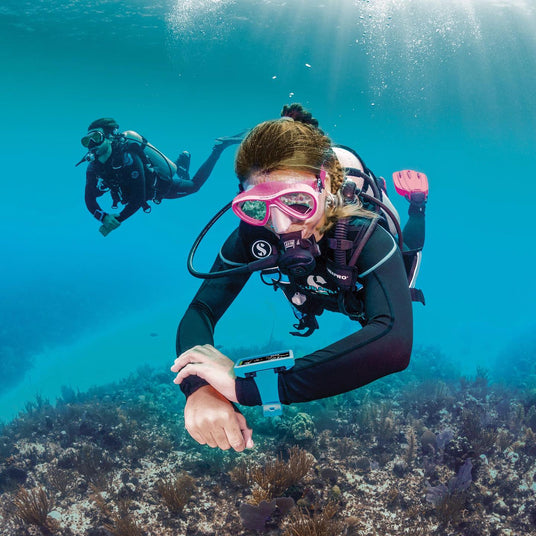
The Importance of a Dive Computer
A dive computer isn't just a nice-to-have gadget—it plays a key role in keeping you safe underwater. It gives you live feedback on your dive profile, allowing you to make informed decisions at every stage. Here's why it's a must for any serious diver:
- Offers dynamic, real-time no-decompression limits that adjust to your specific dive profile—far more precise than traditional dive tables.
- Warns you if you're rising too quickly, helping reduce the risk of decompression sickness.
- Automatically calculates your off-gassing periods and suggests safe wait times before your next dive or flight.
- Many models are compatible with enriched air, and advanced versions support multiple gas switching for technical dives.
- Keeps a digital record of your dives, with options to sync logs to your smartphone or desktop.
- Optional add-ons like wireless air integration, digital compasses, and planning tools give you even more control and safety underwater.
Types of Dive Computers
Key Features to Look For in a Dive Computer
-
Wireless Air Integration
Tracks your tank pressure in real-time using wireless transmitters, helping you monitor how much air remains based on depth and breathing rate.
Who it’s for: Divers wanting to simplify their setup and improve safety by keeping an eye on gas supply without extra gauges.
Tip: Choose models that support Bluetooth or paired sensor pods like the Garmin T2 or Suunto Tank Pod.
-
Support for Nitrox and Trimix Gases
Many modern dive computers handle Nitrox mixtures, while advanced units also accommodate Trimix for deep or technical dives.
Features to check: Ability to set different oxygen percentages and switch between multiple gases mid-dive.
Best suited for: Divers using enriched air or engaging in technical mixed-gas diving.
-
Available Dive Modes
Most dive computers offer a variety of modes to fit different types of diving:
Air Mode: Standard for recreational scuba.
Nitrox Mode: For diving with enriched air mixtures.
Gauge Mode: Functions as a depth timer without decompression tracking.
Freedive Mode: Designed for breath-hold divers with fast response times.
CCR Mode: For closed-circuit rebreather diving, geared toward technical divers.
-
Decompression Algorithms
The software behind your computer’s dive planning is key. Different manufacturers use their own models to calculate safe ascent profiles:
Bühlmann ZHL-16C: Popular in brands like Shearwater and Garmin, allows adjusting conservatism settings.
RGBM (Reduced Gradient Bubble Model): Used by Suunto, Mares, and Cressi, focuses on minimizing bubble formation.
-
Screen Quality and Visibility
A clear display is crucial underwater:
Colour vs. Black & White: Colour displays improve readability, especially in dim conditions.
Backlighting or Always-On: Essential for night diving or murky water.
Large Numerals: Helpful for quick reading, particularly in challenging visibility or for older divers.
-
Battery Options
Consider your power needs and convenience:
Rechargeable Batteries: Environmentally friendly and easy to recharge, often found in wrist-style models.
User-Replaceable Batteries: Useful for extended trips where charging isn’t possible.
-
Built-In Compass
Many dive computers now include digital 3D compasses, which assist in underwater navigation without extra equipment.
-
Connectivity and Dive Logging
Wireless syncing capabilities allow divers to upload logs, update software, and review dive data on smartphones or computers.
Compatible apps: DiverLog+, Shearwater Cloud, Suunto App, Garmin Dive.
-
Before You Make Your Choice
Planning to advance your skills? Pick a dive computer that can keep up with your future certifications.
Need clear visibility underwater? Opt for bright colour screens, large numbers, and strong backlighting.
Love to travel? Go for compact, rechargeable units that can also handle other sports or activities.
Top FAQs About Dive Computers
Do I really need a dive computer, or can I just use dive tables?
Do I really need a dive computer, or can I just use dive tables?
While dive tables can work, dive computers are much safer and more accurate. They track your exact dive profile in real time and adjust no-decompression limits based on your depth, ascent rate, and previous dives - something tables can't do. Most divers today wouldn’t dive without one.
What’s the best dive computer for a first-time diver?
What’s the best dive computer for a first-time diver?
If you're just starting out, look for a simple, user-friendly model with clear screens and Air + Nitrox modes. Top-rated beginner options include the Mares Puck 4, Suunto Zoop Novo, and Shearwater Peregrine. They’re reliable, easy to grow with, and not overloaded with complex features.
What features should I look for in a dive computer?
What features should I look for in a dive computer?
That depends on your diving style. Key features include Nitrox support, wireless air integration, clear display, multiple dive modes (like freediving or tech), and good battery life. If you plan to travel, consider something compact and rechargeable.
What’s the difference between a dive watch and a dive computer?
What’s the difference between a dive watch and a dive computer?
A dive watch tracks time and sometimes depth. A dive computer calculates your no-decompression time, ascent rate, nitrogen loading, and more - it’s essentially your digital dive buddy, keeping you safe underwater.
Is wireless air integration worth it?
Is wireless air integration worth it?
For many divers, yes. Wireless air integration gives you real-time pressure readings from your tank and estimates how much air time you have left. It reduces the need for extra hoses and gauges and improves your awareness of air consumption.
Are dive computers suitable for travel and holidays?
Are dive computers suitable for travel and holidays?
Absolutely. Many dive computers are lightweight, wrist-mounted, and have rechargeable batteries - ideal for dive trips. Models like the Garmin Descent Mk3 and Suunto D5 are great travel companions that double as smartwatches or daily wear.
Can I use the same computer for freediving and scuba?
Can I use the same computer for freediving and scuba?
Only if it has a dedicated freedive mode, which offers faster sampling and accurate surface interval tracking. Many modern computers - like the Shearwater Teric or Suunto D5 - support both styles in one unit.
What algorithm does a dive computer use, and why does it matter?
What algorithm does a dive computer use, and why does it matter?
Algorithms like Bühlmann ZHL-16C or RGBM determine how conservatively your computer calculates your no-deco time. Some let you adjust this (e.g., more cautious settings for cold water or back-to-back dives). It's worth checking if you want more control over your dive profile.
How long do dive computer batteries last?
How long do dive computer batteries last?
Rechargeable models usually give you 20–40 hours per charge, while replaceable batteries can last up to a year. If you’re diving in remote areas, having a user-changeable battery can be a big plus.
Will a dive computer track and store my dive logs?
Will a dive computer track and store my dive logs?
Yes - most modern dive computers save your dive data automatically and can sync to your phone or laptop. Apps like Shearwater Cloud, Garmin Dive, or Suunto App let you review dive profiles, log notes, and even share dives with friends or instructors.
Can I replace the battery in my dive computer myself?
Can I replace the battery in my dive computer myself?
Some models are user-replaceable, while others require professional servicing to maintain waterproof seals. Always check your manual - or contact us if you're unsure.
Do you offer dive computer battery replacements?
Do you offer dive computer battery replacements?
Yes, we do.
We replace all dive computer batteries and all Suunto Dive Computer battery replacements take place onsite at our London Dive store. We have various levels of service ranging from same day battery change, express 1hr service or post in post back options. Usual turnaround is 7-10 days - simply choose whichever suits your needs.
Our London Dive Shop is one of the largest fully authorised Suunto Dive Computer battery change centers in the country. All Suunto Dive Computer battery changes are pressure tested in our very own pressure tester capable of 5ATM's of pressure, and all work is completed by a fully authorised and trained Suunto Technician. All of our dive computer battery changes are covered by a 3 month warranty and we only use authentic manufacturers service kits supplied from the relevant manufacturer.
We also cater for Mares, Oceanic and Scubapro Dive Computers along with most other major brands of dive computers.
I need help choosing a dive computer - can Mike's Dive Store assist?
I need help choosing a dive computer - can Mike's Dive Store assist?
Absolutely! We’re divers ourselves and factory-trained at Mike’s Dive Store, ready to help you find the perfect dive computer. Use our online chat, call or email us, or visit our London store in person.
For personalised advice, you can also book a free video consultation here:
Video Consultations at Mike’s Dive Store
BEST RATED - MIKE'S TOP CHOICE
Garmin Descent Mk3 & Mk3i Dive Computers
The Garmin Descent Mk3 series represents the latest generation of Garmin’s dive computers, blending state-of-the-art dive technology with next-level smartwatch features. Both the Mk3 and Mk3i models feature a stunning AMOLED display, redesigned interface, and DiveView™ mapping, offering crisp underwater visuals and intuitive navigation. With support for multiple dive modes—scuba, freediving, gauge, and CCR—they're ideal for both recreational and technical divers alike.
The Mk3i models take it a step further with SubWave™ sonar-based air integration, allowing real-time tank pressure monitoring and diver-to-diver messaging when paired with the Garmin Descent T2 transmitter. Available in two sizes—43mm and 51mm—the Mk3i suits a variety of wrist sizes without compromising on battery life or features. All models support multisport tracking, GPS logging, health monitoring (including ECG capability in future updates), and Bluetooth sync with the Garmin Dive™ app. Whether you're looking for a premium dive watch or a full-featured dive computer with air integration, the Mk3 series delivers performance, precision, and style.
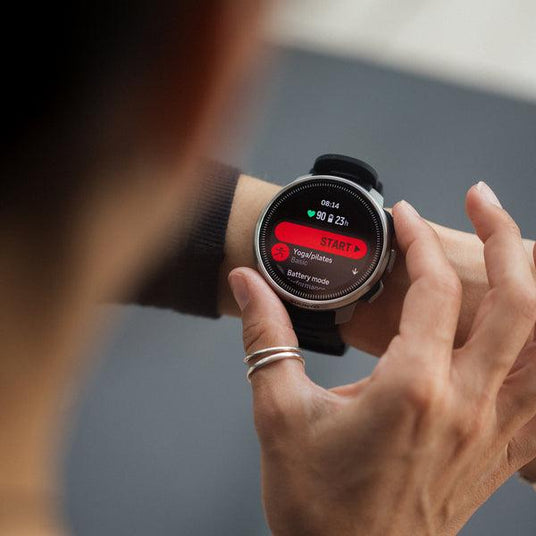
Dive Smart. Live Bold.
Suunto Ocean – Mike’s Dive Store Top Pick for Everyday Divers
A best-selling dive computer loved by customers for its versatility, style, and smart performance.
The Suunto Ocean combines advanced dive technology with everyday smartwatch features, making it the perfect companion both underwater and on land. With a vivid AMOLED touchscreen, wireless tank pressure monitoring (via Tank POD), and support for scuba, freediving, and snorkelling, it's built for versatility and clarity at depth.
Beyond diving, it offers 95+ sport modes, GPS tracking, heart rate, sleep, and recovery metrics—all wrapped in a sleek, lightweight design. Whether you're logging dives or training on land, the Ocean adapts to your lifestyle with seamless performance and stunning style.
Top Rated Dive Computers
View allDiver Favourites
Whether you're a beginner or an experienced diver, choosing the right computer can transform your underwater experience. Here are some of the highest-rated dive computers trusted by divers worldwide, known for their reliability, innovation, and ease of use:
NEW FOR 2025
Garmin Descent™ G2 Dive Computer
The Garmin Descent™ G2 is a rugged, watch-style dive computer designed for both your underwater adventures and everyday life. It’s engineered for divers of all levels, providing advanced tracking, health monitoring, and smart features in a sustainable, eco-friendly design. Whether you’re diving into the deep blue or heading out for a run, the Descent™ G2 is the ultimate companion for your active lifestyle.




